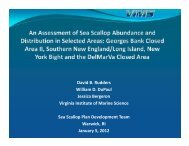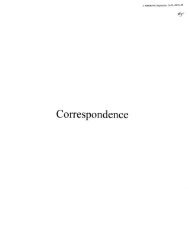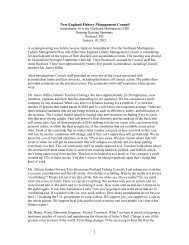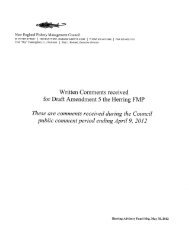Smooth Bottom Net Trawl Fishing Gear Effect on - New England ...
Smooth Bottom Net Trawl Fishing Gear Effect on - New England ...
Smooth Bottom Net Trawl Fishing Gear Effect on - New England ...
Create successful ePaper yourself
Turn your PDF publications into a flip-book with our unique Google optimized e-Paper software.
NOAA/NMFS Unallied Science Project, Cooperative Agreement NA16FL2264 December 2005<br />
<str<strong>on</strong>g>Smooth</str<strong>on</strong>g> <str<strong>on</strong>g>Bottom</str<strong>on</strong>g> <str<strong>on</strong>g>Net</str<strong>on</strong>g> <str<strong>on</strong>g>Trawl</str<strong>on</strong>g> <str<strong>on</strong>g>Fishing</str<strong>on</strong>g> <str<strong>on</strong>g>Gear</str<strong>on</strong>g> <str<strong>on</strong>g>Effect</str<strong>on</strong>g> <strong>on</strong> the Seabed:<br />
Investigati<strong>on</strong> of Temporal and Cumulative <str<strong>on</strong>g>Effect</str<strong>on</strong>g>s BKAM/CR<br />
Mud Hole<br />
During the experimental trawl surveys, the dominant finfish species at Mud Hole were<br />
spiny dogfish, yellowtail flounder, and winter flounder. Skate, crab and m<strong>on</strong>kfish were<br />
also an important comp<strong>on</strong>ent of the catch (Figure 3.6-3).<br />
Mud Hole, Lane 1 and Mud Hole, Lane 3 show similar trends over the study period.<br />
Yellowtail flounder catch increased over the study period at both Mud Hole trawl lanes.<br />
Mud Hole, Lane 1 showed a greater rate of increase during the August to October period<br />
while Mud Hole, Lane 3 had a greater rate of increase between October and November.<br />
Winter flounder catch increased from August to November, but shows less of an increase<br />
at Mud Hole, Lane 1 (Figure 3.6-4).<br />
Skate were more abundant at Mud Hole, Lane 1 over the study period and were most<br />
abundant in November for both trawled lanes. The rock crab populati<strong>on</strong> declined over the<br />
study period but peaked in October at Mud Hole, Lane 3; whereas, a steady decline was<br />
observed at Mud Hole, Lane 1. M<strong>on</strong>kfish abundance remained relatively low throughout<br />
the study period dropping to zero at both trawled lanes in October.<br />
Spiny Dogfish, although not targeted for commercial fishing due to regulati<strong>on</strong>s, was a<br />
dominant comp<strong>on</strong>ent of the total catch <strong>on</strong> both trawl lanes. In August, Mud Hole, Lanes 1<br />
and 3 had comparatively low densities of spiny dogfish. However, the October<br />
experimental tow at Mud Hole, Lane 3 resulted in a density of 291 kg/1000m 2 , 4.5 times<br />
the next highest density of 64.5 kg/1000m 2 at Mud Hole, Lane 1 <strong>on</strong> the same date (Figure<br />
3.6-6). This <strong>on</strong>e tow had a density greater than all other tows over the study period<br />
combined (Photograph 2.2-1).<br />
Little Tow<br />
Similar to Mud Hole, the catch at Little Tow was predominantly yellowtail flounder,<br />
winter flounder, crab, skate, m<strong>on</strong>kfish and spiny dogfish. Finding trends at the Little Tow<br />
study area is somewhat c<strong>on</strong>founded by the fact that no data is available for Little Tow,<br />
Lane 3 <strong>on</strong> November 9, 2002, due to a gear c<strong>on</strong>flict. Lobster gear set al<strong>on</strong>g the lane<br />
made trawling impossible in November.<br />
Yellowtail flounder and skate catch increased over the study period with yellowtail<br />
density reaching its peak of 3.9 kg per 1000m 2 in November (Figure 3.6-5). Winter<br />
flounder densities remained low at both Little Tow lanes, reaching a peak of <strong>on</strong>ly 0.76<br />
kg/1000m 2 in October at Little Tow, Lane 1.<br />
Water temperature is a factor influencing the movement of yellowtail flounder. During<br />
the spring, yellowtail flounder in Massachusetts’ inshore bottom trawl surveys are most<br />
frequently found in waters of 5 to 9 degrees C. Similar fall trawl surveys find yellowtail<br />
most abundant in waters of 9 to 11 degrees C (NOAA-NMFS Essential Fish Habitat<br />
Source Document). This seems c<strong>on</strong>gruent with our finding that the highest densities for<br />
yellowtail flounder were in November when bottom water temperatures were about 10.5<br />
degrees C. It is interesting to note that as the surface water temperature decreased,<br />
bottom water temperatures actually increased over the study period due to mixing of the<br />
58







